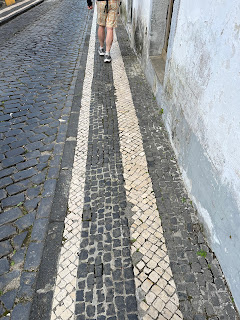From the Azores to Porto, the pavements of Portugal are cobbled with square tiles that form patterns, all in black and white. To get a new sidewalk put in, the design must be approved.
This all started in reference to Portugal's past and its Roman mosaic floors have inspired this modern incarnation.
The Azorean patterns we saw were fairly plain, intended to move the eye as well as the foot.
But in Lisbon, for example, the patterns became quite ornate. Some seemed unnervingly 3D, or as if the pavement was undulating.
For one thing all these "calçada Portuguesa" are uneven. Cobbles are like that. They refuse to lie flat. Especially when there is a requisite space between cobbles. And when those cobbles are decades if not centuries old. The cobbles work themselves loose with wear and weather and create so many big gaps, loose cobbles or portholes ensue.
And don't get me started on the force of gravity on steep, steep paths, where piles of cobbles work themselves loose and tumble down along the sides and bottoms of roads and paths, becoming traffic hazards as well. Cyclists, baby buggies, suitcases with wheels - these are all culprits for dislodging cobbles and also victims of cobble malfunctions. The women who wear stiletto heels on Portugal's sidewalks are either my heroes or need to have their heads examined.
Another problem is the question of grippiness. As cobbles get worn down, or wet in the rain, they can become quite lethally slippery. Porto's famed granite is pretty grippy, but in the Azores basalt is used and in Lisbon limestone is cobble of choice. The white ones are the worst. Many traffic accidents have been caused by these lovely but worrisome cubes of stone.
City councils are now discussing the replacement of these iconic patterned sidewalks and plazas with safer materials. The generally quiet and polite Portuguese however have risen up in defense of these historic markers of their country and have petitioned UNESCO to get them classified so they stay.
I say teach and promote local craftspeople to lay and maintain the wonderfully unique cobbled paths. And wear flat rubber-soled shoes.















.JPG)






No comments:
Post a Comment